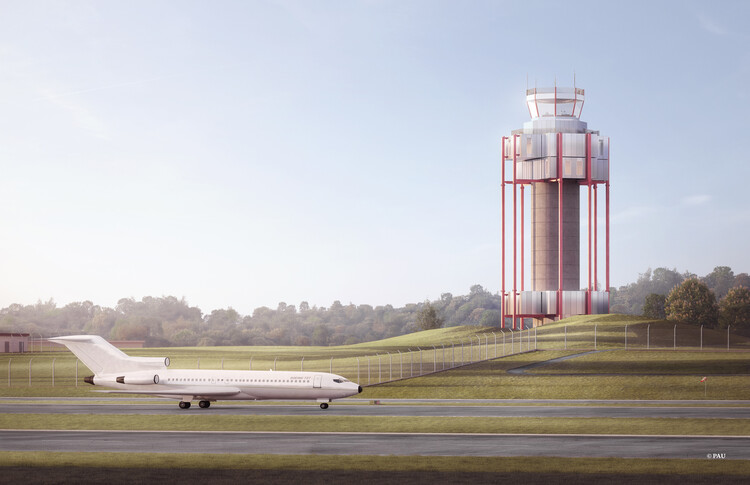New York's PAU Studio To Design Air Traffic Control Towers To Replace I.M. Pei's Mid-Century Structures
New York's PAU studio to design air traffic control towers to replace I.M. Pei's mid-century structures. In an exciting development for the field of architecture, the prestigious New York-based firm, PAU Studio, has been chosen to design the latest air traffic control towers in the United States.
Author:George EvansMay 03, 202332.3K Shares577.8K Views

New York's PAU studio to design air traffic control towersto replace I.M. Pei's mid-century structures. In an exciting development for the field of architecture, the prestigious New York-based firm, PAU Studio, has been chosen to design the latest air traffic control towers in the United States.
PAU Studio's Innovative And Sustainable Design Chosen For New Air Traffic Control Towers
The Federal Aviation Administration has selected the Practice for Architecture and Urbanism (PAU) studio in New York to design the country's newest air traffic control towers.
PAU's adaptable and highly sustainable prototype will replace I.M. Pei's iconic mid-century towers, offering a new architectural solution that combines form and function for the twenty-first century.
The additional towers are critical to Transportation Secretary Pete Buttigieg's objective of achieving net-zero greenhouse gas emissions from the United States' aviation sector by 2050. They have been updated to reflect changes in aviation technology, safety, and environmental and climatic conditions.
The new air traffic control towers will be uniform but customizable, enabling for the customization of materials and colors to meet the needs and reflect the regional identities of their various locations.
The first 30 control towers, which will be built from Detroit, MI to Philadelphia, PA, Louisville, KY, and Key West, FL, might begin construction as soon as 2024. PAU will use geothermal heating and cooling whenever possible to provide clean, renewable energy.
With a diverse portfolio of projects that demonstrate their ability to create spaces that blend harmoniously with their surroundings, PAU Studio has proven their capability to take on ambitious architectural challenges.
PAU Studio's design philosophy revolves around the idea of creating buildings that not only serve their practical purpose but also become integral parts of the communities they inhabit.
They prioritize the human experience, incorporating elements of sustainability, connectivity, and cultural context into their designs. By seamlessly integrating their structures into the urban fabric, PAU Studio aims to enhance the quality of life for residents and users of their buildings.
Implications of Replacing I.M. Pei's Structures: The decision to replace the existing air traffic control towers raises questions about the preservation of architectural heritage. I.M. Pei's designs are recognized as important contributions to the architectural legacy of the mid-20th century.
Therefore, any alteration to these structures must be approached with careful consideration and respect for their historical significance. PAU Studio faces the challenge of creating new towers that pay homage to Pei's vision while meeting the functional and technological demands of the present and future.
The new towers will need to address various requirements, such as improved visibility, enhanced technological integration, and adaptability to changing aviation practices. PAU Studio's task will involve striking a delicate balance between paying tribute to Pei's legacy and providing a fresh, forward-looking interpretation of air traffic control architecture.
The selection of PAU Studio to design the newest air traffic control towers, replacing I.M. Pei's mid-century structures, marks an important chapter in the evolution of architectural design.
Final Words
PAU Studio's innovative approach and commitment to creating buildings that serve the needs of the community position them well to tackle this significant project.
While the replacement of Pei's architectural gems may provoke some debate, the opportunity to create new structures that address the demands of the modern aviation industry and incorporate the latest technological advancements is a compelling one.
The resulting air traffic control towers will not only serve their functional purpose but will also stand as testaments to the progress and ingenuity of architectural design in the 21st century.

George Evans
Author
George Anderson, an exceptional architectural designer, envisions and brings to life structures that transcend the realm of imagination. With an unwavering passion for design and an innate eye for detail, George seamlessly blends form and function, creating immersive spaces that inspire awe.
Driven by a deep appreciation for the interplay of space, light, and materials, George's innovative approach redefines the possibilities of architectural design. His visionary compositions leave an indelible mark, evoking a sense of wonder and transforming the built environment.
George Anderson's transformative designs and unwavering dedication continue to shape the architectural landscape, pushing the boundaries of what is possible and inspiring generations to come.
Latest Articles
Popular Articles